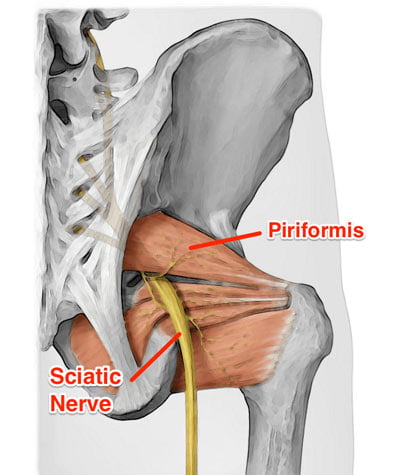While you may be very active and healthy, your level of activity sometimes can lead to serious consequences. Piriformis syndrome occurs from overusing or straining the large, flat piriformis muscle in your rear end. Alternatively, too little exercise can lead to similar outcomes. Only an experienced, leading pain and injury doctor at advanced pain management NYC can diagnose your condition. You need an expert to successfully treat your discomfort through regenerative interventions that ensure you get back to the quality of life you worked so hard to achieve. Schedule an appointment to see if you suffer from piriformis syndrome.
Piriformis syndrome is a condition characterized by intense pain or numbness starting in the region of your buttocks, running down the back of your leg. The piriformis muscle is a flat muscle resembling a band that connects the lowest vertebrae in your back with the top of your leg. It’s located deep in the buttocks, behind the large muscle called the gluteus maximus.
The function of the piriformis muscle is to help you rotate your hip, but it also allows you to turn your foot and leg outward. This muscle lies adjacent to the sciatic nerve, the largest nerve in your body. Piriformis syndrome results from irritation or compression of the sciatic nerve, a condition called sciatica. At pain treatment center New York, the best pain management doctors recommend the most effective piriformis syndrome treatment to relieve your symptoms.
Symptoms of Piriformis Syndrome
Besides sharp pain that radiates from your buttocks, you may feel lower back pain that runs down the back of the leg all the way to your foot. You may also experience tingling and numbness in the same area. Other symptoms of piriformis syndrome include:
- Muscle spasms or discomfort in the buttock area
- Difficulty putting weight on your one side of your buttocks
- Pain when sitting that intensifies as you continue to sit
- Severe lower body pain
- Reduced range of motion of your hip joint
- Increased tenderness with pressure

Your symptoms may develop suddenly or gradually. While you may experience pain on both sides of your body, the pain affects just one side of your lower body in most cases. The pain may increase during certain activities, such as walking up an incline, climbing stairs or exercising.
Causes and Risk Factors for Piriformis Syndrome
The piriformis muscle is used in many of the movements you make with your lower body all the time. Changing position, shifting weight from one foot to the other and walking all require the use of this muscle. You likely don’t give it any thought unless it begins to hurt. If you injure your piriformis muscle from a trauma such as a car accident or fall, the muscle may swell or tighten. This can lead to irritation of the sciatic nerve and the pain of piriformis syndrome.
Overuse of the piriformis muscle can also cause this condition. You may overuse the muscle by sitting for extended periods of time in one position at work, watching TV or engaging in other sedentary hobbies. Continually being involved in activities that require repetitive movements such as walking, bicycling or running put you at risk of damaging the muscle. Muscle spasms can also be triggered by lifting heavy objects or playing sports. In some cases, the cause of piriformis syndrome can’t be identified. For unknown reasons, this condition is more common in women than in men.
Treatment for Piriformis Syndrome
The top pain management specialists in Manhattan may recommend several different treatment options to relieve the pain you’re experiencing from piriformis syndrome. Physical therapy and stretching exercises may be the first line of defense to help decrease painful symptoms along the sciatic nerve and to improve your range of motion.
Other piriformis syndrome treatment options to relieve severe pain include:
- Epidural steroid injections. Corticosteroids are injected into the epidural space around your spinal column to reduce inflammation and swelling. Injections are guided by x-ray or ultrasound. This interventional treatment relieves you of pain, giving the muscle time to heal.
- Injection into piriformis muscle. Corticosteroids may also be injected directly into the piriformis muscle to reduce pain and spasms.
- Nerve block injection. This is another form of intervention that allows your muscle and surrounding tissue time to regenerate and heal. It works by temporarily deadening the nerve that normally signals the pain.
- Radiofrequency ablation. For this non-surgical treatment, your pain management doctor uses heat to block the transmission of pain signals, allowing you to experience less pain.
- Spinal cord stimulator. This is one of a number of minimally invasive procedures that your top pain doctors in Manhattan rely on. It uses electrical stimulation to block the sensation of pain and reduce spasms.
Symptoms of piriformis syndrome may come and go, but should improve with treatment. Contact the doctors at Pain Management NYC to find out the best piriformis syndrome treatment for you. All treatments at the NYC pain management clinic are designed with your specific needs and goals in mind.

Boleslav Kosharskyy, MD, is a top-rated, best-in-class interventional pain management doctor. He is board-certified in Anesthesiology, Interventional Pain Medicine, and Palliative Care.
Dr. Kosharskyy is an Associate Professor of Anesthesiology and Rehabilitation Medicine at Albert Einstein Medical College. He’s also the Associate Medical Director of Pain Medicine and Director of Anesthesia for the Joint Replacement Center at Montefiore Medical Center and Albert Einstein Medical College.
He is an active member of the American Society of Anesthesiology (ASA), the American Society of Regional Anesthesia and Pain Medicine (ASRA), and the New York State Society of Anesthesiologists (NYSSA)
